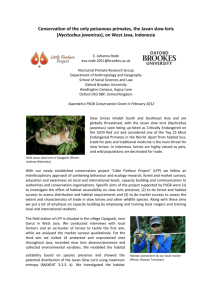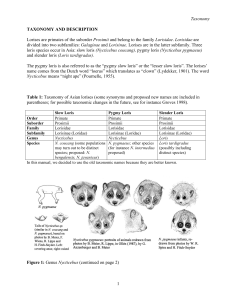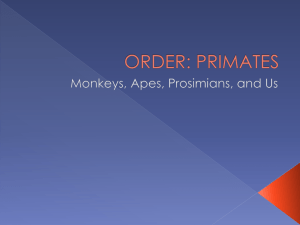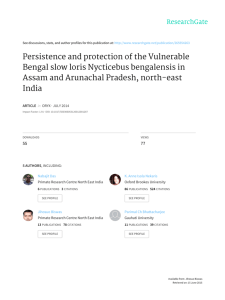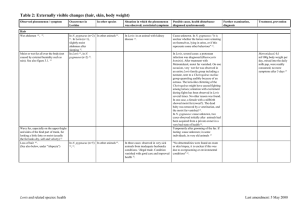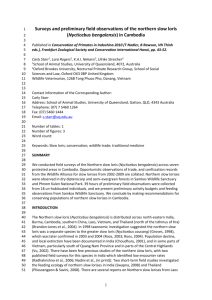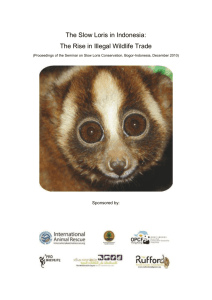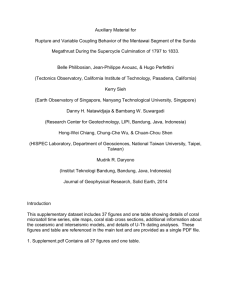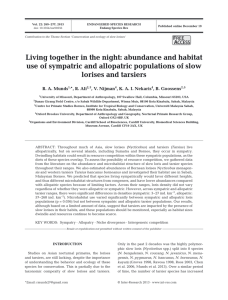Loris in the wild: encounter
advertisement
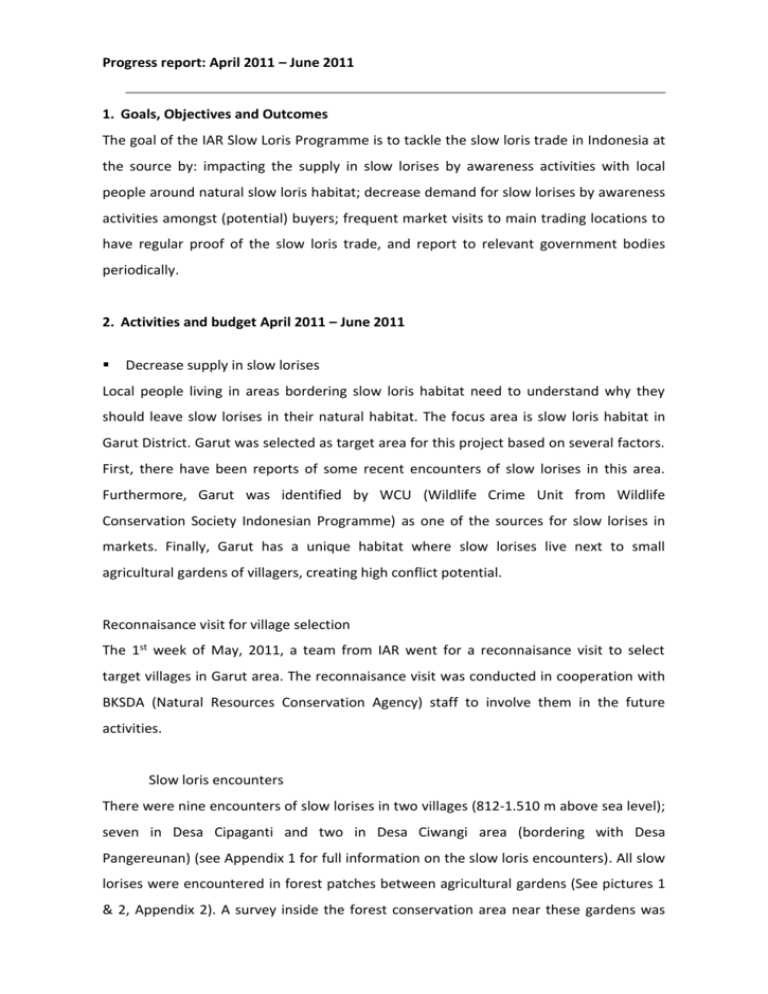
Progress report: April 2011 – June 2011 1. Goals, Objectives and Outcomes The goal of the IAR Slow Loris Programme is to tackle the slow loris trade in Indonesia at the source by: impacting the supply in slow lorises by awareness activities with local people around natural slow loris habitat; decrease demand for slow lorises by awareness activities amongst (potential) buyers; frequent market visits to main trading locations to have regular proof of the slow loris trade, and report to relevant government bodies periodically. 2. Activities and budget April 2011 – June 2011 Decrease supply in slow lorises Local people living in areas bordering slow loris habitat need to understand why they should leave slow lorises in their natural habitat. The focus area is slow loris habitat in Garut District. Garut was selected as target area for this project based on several factors. First, there have been reports of some recent encounters of slow lorises in this area. Furthermore, Garut was identified by WCU (Wildlife Crime Unit from Wildlife Conservation Society Indonesian Programme) as one of the sources for slow lorises in markets. Finally, Garut has a unique habitat where slow lorises live next to small agricultural gardens of villagers, creating high conflict potential. Reconnaisance visit for village selection The 1st week of May, 2011, a team from IAR went for a reconnaisance visit to select target villages in Garut area. The reconnaisance visit was conducted in cooperation with BKSDA (Natural Resources Conservation Agency) staff to involve them in the future activities. Slow loris encounters There were nine encounters of slow lorises in two villages (812-1.510 m above sea level); seven in Desa Cipaganti and two in Desa Ciwangi area (bordering with Desa Pangereunan) (see Appendix 1 for full information on the slow loris encounters). All slow lorises were encountered in forest patches between agricultural gardens (See pictures 1 & 2, Appendix 2). A survey inside the forest conservation area near these gardens was also done, but not one slow loris was encountered here. Possible explanations for this are the growing of trees in groups (rather than mixed), because of the presence of Macaca fascicularis in the forest, or lower changes of spotting the nocturnal lorises in the more dense conservation area. Slow loris knowledge and awareness Information was gathered using a survey (questionnaire and guided discussions), including: Do they know what a slow loris is? Do they know the slow loris is protected? What does this mean to them? What else they know about the slow loris? Does the slow loris have value for them in the wild? What value? Does the slow loris have value for them if they catch it? What value? This information will be used to determine the starting point and message of the campaign. The effectiveness of the campaign will be measured through a pre- and post-campaign questionnaire. A total of 36 respondents were interviewed; 16 in Papandayan and 20 in Limbangan. Respondents’ age ranged from 19 to 60 years old, with a variety of occupations including farmers, teachers, KSDA staff, Forestry Department staff, drivers, and housewives. The main conclusions of the interview are: (1) The majority of the respondents (92%) recognise the slow loris, a smaller portion (56%) has ever seen in a slow loris themselves. (2) Only 19% of respondents know that the slow loris is protected by law. (3) 33% of respondents did not know any risks of capturing a slow loris. 22% mentiona the risk of being punished by law, 19% believes in a myth which will bring bad luck if one catches a slow loris. (4) The respondents also tend to have poor knowledge on the benefit of slow loris (33%) and thought that loris is dangerous for them (47%). Two villages, Papandayan (Desa Cipaganti Kecamatan Cisurupan) and Limbangan (Desa Ciwangi Kecamatan Limbangan), were selected for further awareness activities, because from the survey it was concluded that wild slow lorises inhabit the forest patches in between the gardens of people from this village. Furthermore, in the interviews it was discovered that local people would move the slow loris whenever they encounter him near the village or gardens. The awareness campaign aims to convince people that slow lorises are beneficial for the overall environment and they should be left where they are. Law enforcement Due to lack of law enforcement, people are not afraid to catch, sell or buy a slow loris. If penalties for catching, selling or buying a slow loris are real, or perceived to be real, trade will go down (perceived risks > perceived benefit). In order to push for enforcement, IAR makes sure those responsible are constantly aware of the slow loris trade by: - Documenting the trade each month as proof provided to the authorities to put pressure. Cooperation with WCU in order to minimize double efforts. - Media will be used to use the documentation for more pressure. - Assistence to the Forestry Department in law enforcement efforts. Visits to trading location The target location were markets that have been known to sell slow lorises in Jakarta and Bandung. The markets in question were Pasar Jatinegara and Pasar Barito in Jakarta, and Gasibu and Bandung Indah Plaza in Bandung. One more location was visited, because of recent reports of slow loris trade: Pasar Kaget of Pemda Cibinong in Bogor. The investigators were volunteers from Yayasan IAR Indonesia, as well as a collaboration with WCU (Wildlife Crime Unit) that has their own regular illegal trade investigation in some markets in Jakarta. In all locations – Jakarta, Bandung, and Bogor – the slow loris is commonly sold as ‘kuskus’. The price ranges from Rp 90,000 (about 9 US $) to Rp 300,000 (about 30 US $). The traders explain to potential sellers how to keep the loris as a pet; they provide information on what food to give (banana and papaya). None of them, however, explained that the slow loris is a nocturnal animal. The slow lorises are usually housed individually or pairs, in a box or common dog/cat cage. See Appendix 3 for the documentation taken during the market visits. Media Involvement IAR was the guest in a talkshow of GreenRadio FM Jakarta. The talkshow aimed to inform the audience about the slow loris and its conservation status. During the talkshow, the audience asked many question about the slow loris. It was obvious that generally people did not know the slow loris species, sometimes the slow loris was confused with the ‘kuskus’. At the end of the talkshow, the audience was asked to not participate in the slow loris trade: so, not buying a slow loris – even out of pity – and not to keep a slow loris as a pet. Decrease demand in slow lorises Socialization amongst (potential) buyers The potential buyers that are the main focus of this campaign are people that might buy a slow loris in the market out of pity. They should realize why they only fuel the trade with this. Also, a potential target is people that would not buy the animal if they knew the slow loris’s protection status. The people that do not care, are likely to be more difficult to impact and will not be the focus in this first activity. The target cities are Jakarta and Bandung. At first, locations near the markets were targeted, but this appeared unsafe because of the unfriendly situation with the people of the market. Then the target was selected to the housing complexes and schools. While the awareness materials (stickers, flyers and storybook) are still in production, awareness activities at these locations are pending. Social media and other internet tools are used to raise awareness (Facebook group, mailing lists, IAR blog). In cooperation with the regular IAR program, activities in schools are organised. Also, visits to campuses have been made to present about the slow loris and search volunteers for the programme; so far, the Biology campus of Padjadjaran University and the University of Indonesia have been visited. Appendix 1. Slow loris encounters during reconnaisance survey Loris No. Location Altitude Tree height Cordinate (above sea height in tree Position level) (m) (m) 8 7 Time Tree encountered Note 01:00 PM adult & infant/juvenile I, 3/5/2011 in Papandayan Habitat 1 2 3 4 5 6 7 Cigandasoli, Desa S 7o16'50.1" Cipaganti E Cigandasoli, Desa S 7o16'49.8" Cipaganti E 107o45'43.0" Cigandasoli, Desa S 7o16'48.8" E Cigandasoli, Desa S 7o16'47.0" Cipaganti E 107o45'37.0" Cigandasoli, Desa S 7o16'46.7" code KS1-030511 1475 - - Bamboo 08:40 PM juvenile, code KS2-030511 1479 - - Bamboo 08:53 PM adult, code KS3-030511 1503 7 7 Cajuputi 09:15 PM code KS4-030511 1510 12 10 Bamboo 09:25 PM code KS5-030511 1428 2 1.5 Caliandra 09:28 PM juvenile, kode KS6-030511 1475 7 2 Bamboo 09:45 PM code KS7-030511 838 8 7 Bamboo 10:35 code KS8-050511 812 12 11 Bamboo 12:50 code KS9-050511 107o45'35.8" Cipaganti E Kubang, Desa S 7o16'52.7" 107o45'55.2" Cipaganti E Cigandasoli, Desa S 7o16'50.1" E Bamboo 107o45'37.7" Cipaganti Cipaganti 1465 107o45'44.2" 107o45'41.6" 5/5/2011 in Limbangan Habitat 8 9 Cileunca, Desa S 6o59'44.5" 107o57'49.5" Ciwangi E Cikuluwut, Desa S 6o59'42.9" Pangereunan o E 107 57'26.4" Appendix 2. Pictures Reconnaisance Survey Picture 1. Target location: Garut District, West Java, Indonesia Picture 2. Upper: habitat of KS8-050511 at Cileunca, Desa Ciwangi Kecamatan Limbangan Garut is in the top of bukit in the edge of Manihot garden belongs to villagers. Under: habitat of KS1030511 at Cigandasoli Desa Cipaganti Kecamatan Cisurupan Garut. The loris was found sleeping in bamboo clump in riverside near the Manihot garden belongs to villagers. Appendix 3. Pictures Market Visits April 2011 May 2011 Pasar Jatinegara, East Jakarta Gasibu, Bandung The slow loris was in a cage beneath a wire cage with kittens. It was supposed to be a Juvenile The observations were done three times, pictures were taken on one visit only. There were both Javan slow lorises and Sumatran slow lorises, displayed in cages piled up with cages with other animal species. The slow lorises on display were 2-7 individuals for the three visits (weekly visits in April 2011). Javan slow loris, his fur had been died. The trader offered it for Rp. 200,000. May 2011 May 2011 Bandung Indah Plaza, Bandung Weekend Market Pemda Cibinong, Bogor There were a total of six adult slow There were four slow lorises, individually lorises and one juvenile slow loris, housed in wire cages 30cm x 30cm; all adult displayed in a packaging box of instant Javan slow lorises. The trader offered the noodles, two individuals per box. The loris as 'kuskus' for Rp 150,000, with a slow lorises were offered for Rp 200,000. discount to Rp 90,000. His banner advertised All were Javan slow lorises. for his permanent pet shop in Yasmin Street, Bogor. May 2011 Pasar Barito, South Jakarta There were three slow lorises in one cage (about 50cm x 90cm); two adults, one juvenile. All were Sumatran slow loris. The trader offered the loris as 'kuskus' for Rp 200,000.
